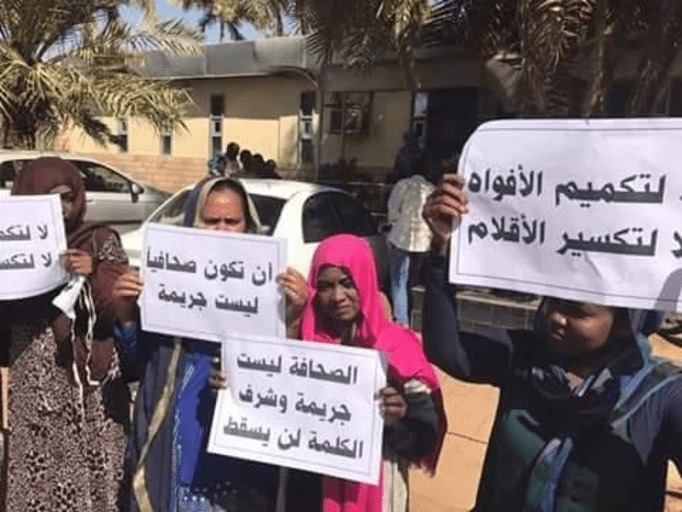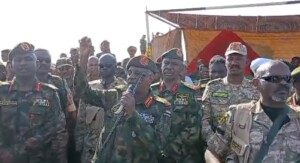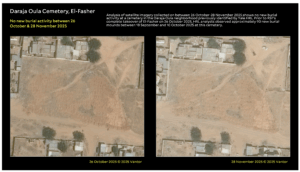Sudanese women journalists: systematic targeting and a heavy price in wartime

Women journalists protest for press freedom (File photo: Sudan Media Forum)
Prepared by Mashaweer for Sudan Media Forum
Sudanese women journalists have paid a heavy price concerning their lives, security and livelihoods over the two years of war raging between the army and the Rapid Support Forces (RSF) since April 2023. Women media workers have faced regular threats, and press freedom has vanished amid interference and obstruction from both warring parties. Both sides have also disregarded International Humanitarian Law (IHL) provisions meant to protect journalists’ ability to work and move freely during conflict, which serve as a key defence against severe civilian abuses.
As a result of these conditions, women journalists have faced intimidation in several regions and cities. Last April, authorities in Kassala state, eastern Sudan, arrested journalist Imtithal Abd Al-Fadil for three days and prevented her from traveling abroad, in a flagrant violation of press freedom guaranteed by the constitution, laws, and international treaties.
Incidents and violations
According to the Sudanese Journalists Syndicate, five women journalists have been assassinated since the war began. There have been four documented cases of physical assault or injury involving women journalists, and 11 women journalists have been victims of shootings.
Meanwhile, 12 women journalists have been arrested without clear legal orders, often due to their journalistic work or writings critical of the authorities, the army, or the RSF.
Continuous deterioration
In this context, Iman Fadl Al-Sayed, Freedoms Secretary at the Sudanese Journalists Syndicate, explained that “the conditions for women journalists have been continuously deteriorating since the war broke out. The suffering takes various forms, from the shutdown of institutions to direct targeting, leading to weakened media coverage of the war.”
She noted a lack of war correspondents in Sudanese newspapers and radio stations due to limited experience and training for working in armed conflict situations, and that “international satellite channel correspondents have failed to adequately convey the scale of events, despite huge civilian casualties and a worsening humanitarian crisis where famine has reached critical levels, meaning hunger leading to death.” She added, “Social media platforms are subject to the whims of individuals or groups with conflicting interests.”
She pointed out that “media outlets aligned with the warring parties now dominate and control information, rejecting neutral or professional reporting, or reliable sources that convey the facts of the war, due to their desire to reflect each party’s specific viewpoints to reach public opinion while ensuring no opposing public opinion is formed against them.”
Fadl Al-Sayed noted that “1,000 male and female journalists have stopped working, hundreds have opted to migrate to neighbouring countries, and others have lost their property and basic rights enshrined in international covenants, such as the right to housing, work, and a dignified life.”
The Freedoms Secretary considered that “the war conditions have cast a shadow over the ability of women journalists to move around and contact sources to obtain information and news, especially with both sides of the conflict targeting women journalists and restricting their movement and activities. With the increasing polarization imposed by the reality of war, their commitment to professional values and rules of neutrality, objectivity, and integrity has significantly declined.”

(Image: UNESCO/Marc James)
Urgent measures
On the same note, Sudanese journalist Samar Suleiman told the Mashaweer platform that “during the war, women journalists have been subjected to various types of systematic attacks aimed at silencing them and preventing them from reporting facts and covering events. Both sides of the conflict also exert significant pressure on women journalists, including threats of death and physical liquidation [elimination], as well as confiscation of equipment and closure of media institutions.”
She added, “Faced with these grave violations, there is an urgent need to establish effective mechanisms to protect women journalists and provide the necessary guarantees for them to carry out their work freely and safely. This requires obliging the Sudanese Army and RSF to apply international laws, foremost among them the Geneva Conventions and international human rights law (IHRL), as well as investigating violations against women journalists, bringing those responsible to justice, and ending impunity.”
Suleiman explained that “women journalists affected by the war need psychological and social support (psychosocial support) to help them overcome the trauma resulting from the violations. Additionally, urgent measures must be taken by online newspapers to ensure a safe working environment for women journalists, including providing protective equipment and safety training.”
She pointed out that “the increasing rates of violations against women journalists pose a serious threat to press freedom and human rights, hindering the reporting of facts and coverage of events. Addressing these violations requires the concerted efforts of the international community, both sides of the conflict, and civil society organizations to establish effective protection mechanisms for women journalists and ensure accountability for perpetrators.”

This report was prepared by Mashaweer and published via the platforms of Sudan Media Forum member organisations on the occasion of World Press Freedom Day to shed light on the situation of journalism and journalists in Sudan.
#SilenceKills #الصمت_يقتل #NoTimeToWasteForSudan #الوضع_في_السودان_لايحتمل_التأجيل #StandWithSudan #ساندوا_السودان #SudanMediaForum #PressFreedom #WorldPressFreedomDay











 and then
and then